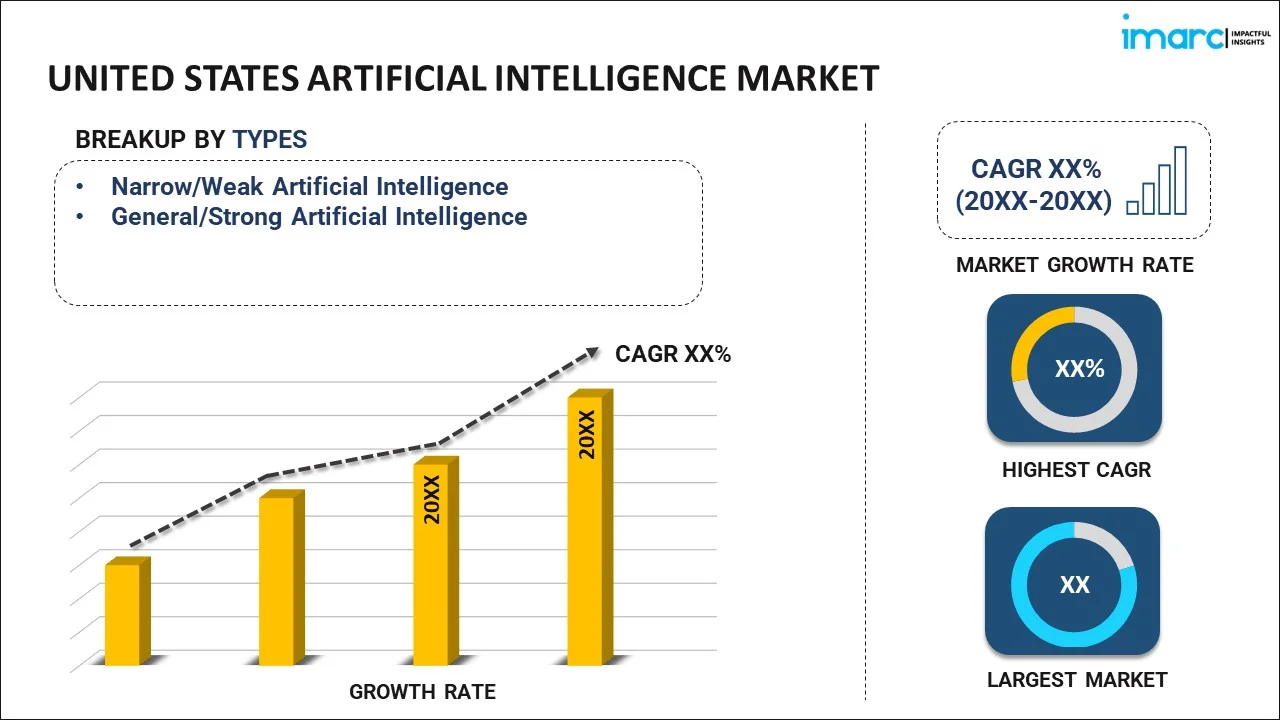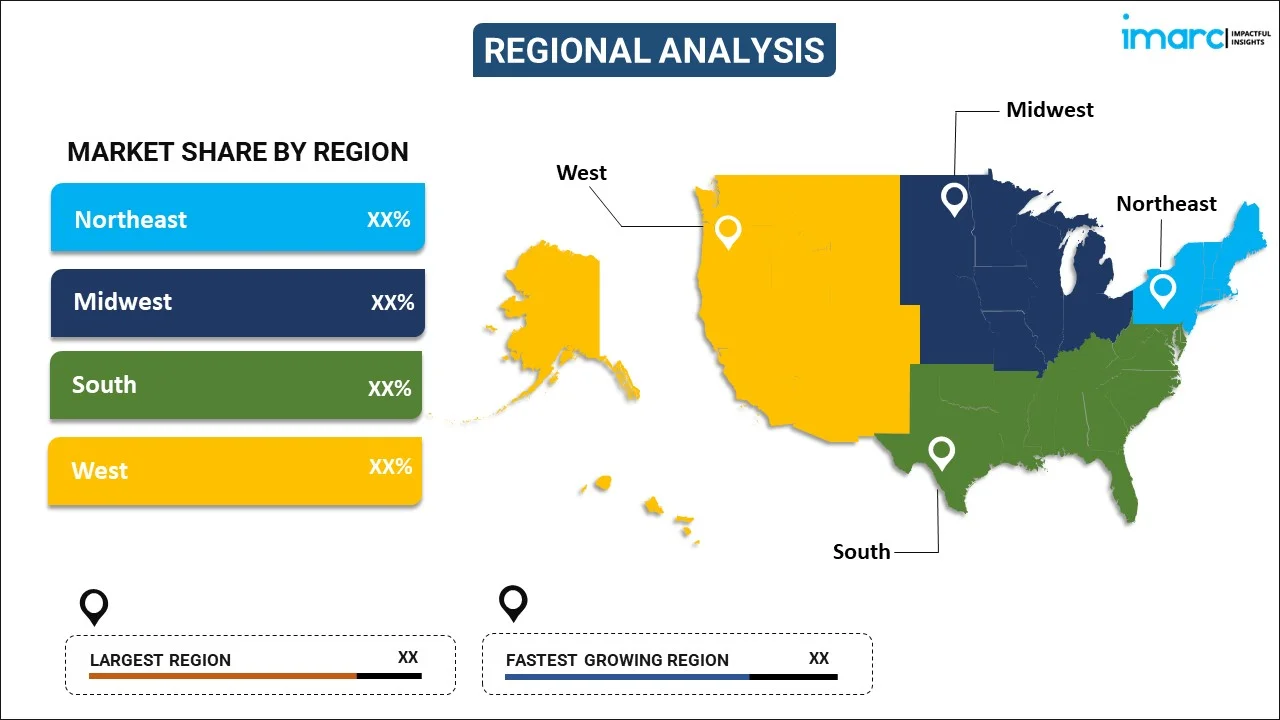
United States Artificial Intelligence Market Report by Type (Narrow/Weak Artificial Intelligence, General/Strong Artificial Intelligence), Offering (Hardware, Software, Services), Technology (Machine Learning, Natural Language Processing, Context-Aware Computing, Computer Vision, and Others), System (Intelligence Systems, Decision Support Processing, Hybrid Systems, Fuzzy Systems), End-Use Industry (Healthcare, Manufacturing, Automotive, Agriculture, Retail, Security, Human Resources, Marketing, Financial Services, Transportation and Logistics, and Others), and Region 2026-2034
Market Overview:
The United States artificial intelligence market size reached USD 41,532.7 Million in 2025. Looking forward, IMARC Group expects the market to reach USD 112,187.7 Million by 2034, exhibiting a growth rate (CAGR) of 11.67% during 2026-2034.
|
Report Attribute
|
Key Statistics
|
|---|---|
|
Base Year
|
2025
|
|
Forecast Years
|
2026-2034
|
|
Historical Years
|
2020-2025
|
|
Market Size in 2025
|
USD 41,532.7 Million |
|
Market Forecast in 2034
|
USD 112,187.7 Million |
| Market Growth Rate (2026-2034) | 11.67% |
Artificial intelligence (AI) aims to simulate human intelligence for developing programmable machines. These machines are capable of learning, planning, recognizing human-like speech and problem-solving based on past experiences. They comprise hardware components like chipsets with high computing capabilities, including graphics processing unit (GPU), application-specific integrated circuits (ASIC), central processing unit (CPU) and field-programmable gate array (FPGA). On the other hand, the software components include core technologies, such as deep learning, natural language processing (NLP), machine learning (ML) and augmented and virtual reality (AR/VR), which can process data and provide meaningful insights.
Digitalization, along with significant reliance on smart devices, has resulted in the increasing use of AI-integrated systems for analyzing large amounts of data and improving overall operational efficiency in the United States. For instance, Netflix, Inc., an American media service provider, relies on AI-driven data insights to provide suggestions to users according to their viewing history. Other factors like high demand for intelligent virtual assistants, increasing use of AI-powered industrial and surgical robots and the expansion of the 5G infrastructure are positively influencing the market in the country.
Key Market Segmentation:
IMARC Group provides an analysis of the key trends in each segment of the United States artificial intelligence market report, along with forecasts at the country level from 2026-2034. Our report has categorized the market based on type, offering, technology, system, and end-use industry.
Breakup by Type:

To get more information on this market Request Sample
- Narrow/Weak Artificial Intelligence
- General/Strong Artificial Intelligence
Breakup by Offering:
- Hardware
- Software
- Services
Breakup by Technology:
- Machine Learning
- Natural Language Processing
- Context-Aware Computing
- Computer Vision
- Others
Breakup by System:
- Intelligence Systems
- Decision Support Processing
- Hybrid Systems
- Fuzzy Systems
Breakup by End-Use Industry:
- Healthcare
- Manufacturing
- Automotive
- Agriculture
- Retail
- Security
- Human Resources
- Marketing
- Financial Services
- Transportation and Logistics
- Others
Breakup by Region:

To get detailed segment analysis of this market Request Sample
- Northeast
- Midwest
- South
- West
Competitive Landscape:
The competitive landscape of the industry has also been examined along with the profiles of the key players.
Report Coverage:
| Report Features | Details |
|---|---|
| Base Year of the Analysis | 2025 |
| Historical Period | 2020-2025 |
| Forecast Period | 2026-2034 |
| Units | Million USD |
| Segment Coverage | Type, Offering, Technology, System, End-Use Industry, Region |
| Regions Covered | Northeast, Midwest, South, West |
| Customization Scope | 10% Free Customization |
| Post-Sale Analyst Support | 10-12 Weeks |
| Delivery Format | PDF and Excel through Email (We can also provide the editable version of the report in PPT/Word format on special request) |
Key Questions Answered in This Report:
- How has the United States artificial intelligence market performed so far and how will it perform in the coming years?
- What are the key regional markets?
- What is the breakup of the market based on the type?
- What is the breakup of the market based on the offering?
- What is the breakup of the market based on the technology?
- What is the breakup of the market based on the system?
- What is the breakup of the market based on the end-use industry?
- What are the various stages in the value chain of the industry?
- What are the key driving factors and challenges in the industry?
- What is the structure of the United States artificial intelligence market and who are the key players?
- What is the degree of competition in the industry?
Need more help?
- Speak to our experienced analysts for insights on the current market scenarios.
- Include additional segments and countries to customize the report as per your requirement.
- Gain an unparalleled competitive advantage in your domain by understanding how to utilize the report and positively impacting your operations and revenue.
- For further assistance, please connect with our analysts.
 Request Customization
Request Customization
 Speak to an Analyst
Speak to an Analyst
 Request Brochure
Request Brochure
 Inquire Before Buying
Inquire Before Buying




.webp)




.webp)












